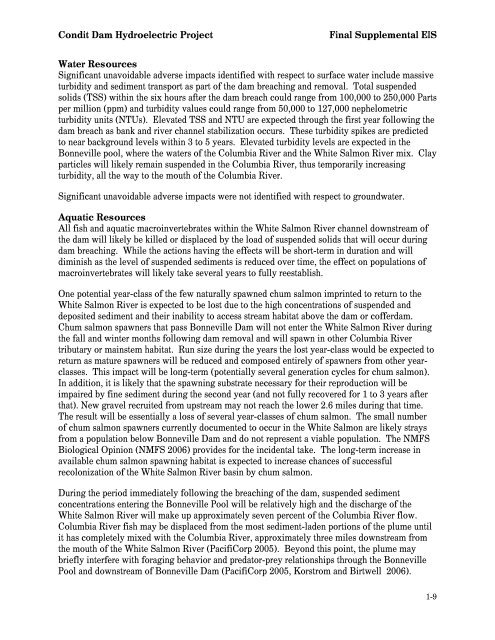Condit Dam Removal Condit Dam Removal - Access Washington
Condit Dam Removal Condit Dam Removal - Access Washington
Condit Dam Removal Condit Dam Removal - Access Washington
You also want an ePaper? Increase the reach of your titles
YUMPU automatically turns print PDFs into web optimized ePapers that Google loves.
<strong>Condit</strong> <strong>Dam</strong> Hydroelectric Project<br />
Final Supplemental EIS<br />
Water Resources<br />
Significant unavoidable adverse impacts identified with respect to surface water include massive<br />
turbidity and sediment transport as part of the dam breaching and removal. Total suspended<br />
solids (TSS) within the six hours after the dam breach could range from 100,000 to 250,000 Parts<br />
per million (ppm) and turbidity values could range from 50,000 to 127,000 nephelometric<br />
turbidity units (NTUs). Elevated TSS and NTU are expected through the first year following the<br />
dam breach as bank and river channel stabilization occurs. These turbidity spikes are predicted<br />
to near background levels within 3 to 5 years. Elevated turbidity levels are expected in the<br />
Bonneville pool, where the waters of the Columbia River and the White Salmon River mix. Clay<br />
particles will likely remain suspended in the Columbia River, thus temporarily increasing<br />
turbidity, all the way to the mouth of the Columbia River.<br />
Significant unavoidable adverse impacts were not identified with respect to groundwater.<br />
Aquatic Resources<br />
All fish and aquatic macroinvertebrates within the White Salmon River channel downstream of<br />
the dam will likely be killed or displaced by the load of suspended solids that will occur during<br />
dam breaching. While the actions having the effects will be short-term in duration and will<br />
diminish as the level of suspended sediments is reduced over time, the effect on populations of<br />
macroinvertebrates will likely take several years to fully reestablish.<br />
One potential year-class of the few naturally spawned chum salmon imprinted to return to the<br />
White Salmon River is expected to be lost due to the high concentrations of suspended and<br />
deposited sediment and their inability to access stream habitat above the dam or cofferdam.<br />
Chum salmon spawners that pass Bonneville <strong>Dam</strong> will not enter the White Salmon River during<br />
the fall and winter months following dam removal and will spawn in other Columbia River<br />
tributary or mainstem habitat. Run size during the years the lost year-class would be expected to<br />
return as mature spawners will be reduced and composed entirely of spawners from other yearclasses.<br />
This impact will be long-term (potentially several generation cycles for chum salmon).<br />
In addition, it is likely that the spawning substrate necessary for their reproduction will be<br />
impaired by fine sediment during the second year (and not fully recovered for 1 to 3 years after<br />
that). New gravel recruited from upstream may not reach the lower 2.6 miles during that time.<br />
The result will be essentially a loss of several year-classes of chum salmon. The small number<br />
of chum salmon spawners currently documented to occur in the White Salmon are likely strays<br />
from a population below Bonneville <strong>Dam</strong> and do not represent a viable population. The NMFS<br />
Biological Opinion (NMFS 2006) provides for the incidental take. The long-term increase in<br />
available chum salmon spawning habitat is expected to increase chances of successful<br />
recolonization of the White Salmon River basin by chum salmon.<br />
During the period immediately following the breaching of the dam, suspended sediment<br />
concentrations entering the Bonneville Pool will be relatively high and the discharge of the<br />
White Salmon River will make up approximately seven percent of the Columbia River flow.<br />
Columbia River fish may be displaced from the most sediment-laden portions of the plume until<br />
it has completely mixed with the Columbia River, approximately three miles downstream from<br />
the mouth of the White Salmon River (PacifiCorp 2005). Beyond this point, the plume may<br />
briefly interfere with foraging behavior and predator-prey relationships through the Bonneville<br />
Pool and downstream of Bonneville <strong>Dam</strong> (PacifiCorp 2005, Korstrom and Birtwell 2006).<br />
1-9




